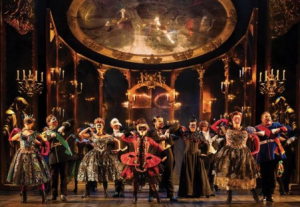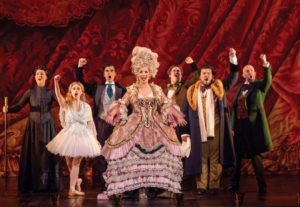The New Production. By Andrew Lloyd Webber, Charles Hart and Richard Stilgoe. Opera Australia and The Really Useful Company, in association with Cameron Mackintosh. Joan Sutherland Theatre, Sydney Opera House. Opened 26th August, 2022.
Reviewed : 26 August, 2022*

In the bowels of the Paris Opera House, this ‘new’ Phantom hides away in a lush but dark world where flickering candles in gold candelabras cast shadows around an ancient keyboard, a strange music box and the few pieces of furniture he has collected to warm his lonely life. What a contrast it is to the colourful, lively world of the operas that are performed above him!
“Phantom” is a story of contrasts: dark versus light, despair and vengeance versus optimism and joy. In his new take on The Phantom accentuates that contrast. The dark is even more gloomy and melancholy – the light even brighter and more carefree.

Earlier this year Sydney audiences watched the incredible spectacle of a brilliant production of “Phantom” in front of a backdrop of a shining, rain-cleansed harbour. Audiences in theatres all over the world have marvelled at music and gasped at the falling chandelier, the boat, the pyrotechnics.
In this re-imagined production, audiences are creatively transported into the Paris Opera House in the early 1900s and the stage of a colourful production of Hannibal. They are led along a labyrinth of dark, backstage passages and a precarious stairway into the deep despair of Erik’s desolation. The music in all its splendour, still sparkles with the chandelier, just as it has sparkled for the past 36 years, but in this production the setting is makes it seem closer, more immersive.
Cameron Mackintosh’s idea of contrasting “the Phantom’s darker backstage world with that of the traditional opera world onstage” has been realised by the incredible imagination of opera designer Paul Brown, who went back to the score, the libretto and Gaston Leroux’s original 1912 novel for inspiration. His research led him to create a “world of contrasts” that resulted in “dirty crumbling backstage corridors in counterpoint to the grand opulence of the gold proscenium. The real textures of bricks and pipes in conflict with the painted scenery of palm trees” and a Phantom’s lair that “became a magpie’s nest of stolen objects”.
Some might say that between them Mackintosh and Brown have transformed The Phantom from a musical into an opera! It has always had the feel of an opera. The macabre theme. The evocative music. The operatic characters. The little bits of comedy. The sad ending. Paul Brown’s new set – and Maria Bjornson’s original and still exquisite costumes – add the “opera” that is promised in the title.
The staging of “Phantom” has always been problematic for directors – the chandelier, the water, the boat – but 36 years of technological development means Brown’s haunting design ideas are stunningly achievable. The cast of Hannibal disperse as the stage evolves to become the high brick wall of the Paris Opera House where Erik leads a reluctant Christine down steps that miraculously slide out from the bricks, then disappear back into the brickwork as they reach the bottom and the boat that will take them across the misty waters of the lagoon. Smoothly walls open to reveal the ominous shadows of Erik’s lair.

Accentuated by height and the variable juxtapositions of lights and projections, every scene becomes more atmospheric, more real, and more immersive. Add the music, the singing, the acting, the dancing and the colour and glitter of the costumes, this production has lots of everything – probably summed up in the brilliance of “Masquerade”, which has it all!
Josh Piterman cements his critical acclaim as The Phantom in the London production in 2019. Singer and actor, he finds the loneliness and longing of this sad recluse. In “The Music of the Night” that sadness rises powerfully up and beyond the stage. There is the strength of determination mixed with the weakness of humiliation in Piterman’s Erik, a man covering rejection with music and the yearning for love and acceptance.

Australian-American Amy Manford also reprises her London and Athens performances as Christine. The clarity and power of her voice captures the imagination of the audience – as well as the hearts of Erik – and Raoul. She moves from hopeful singing pupil to diva, to lover and to anguished captive with elegant ease and emotion.
Blake Bowden plays Raoul with similar elegance and emotion. He brings a wealth of stage and screen experience to this role, finding the passion of both the music and the ardour with which Raoul defends Christine.
Giuseppina Greech is appealingly funny, charming the audience with her beautiful voice and her petulant depiction of the up-staged Carlotta. Paul Tabone plays the huffy Ublado Piangi whose Hannibal is so disastrously ruined by a falling sandbag and Carlotta’s stormy exit from the stage. Tabone is no stranger to this role, having played it in over 1600 performances in London, and he does so with comic panache.
David Whitney and Andy Morton show a different kind of panache as opera mangers Messieurs Firmin and André. Their comic timing and characterisation are indicative of their experience in opera, musical theatre and stage.

Jayde Westaby is the gracious but strict dance ballet mistress, Mme Giry. Mietta White plays her young daughter Meg, who introduces her friend Christine to Firmin and André as a replacement for Carlotta. It is her suggestion that starts the tangled plot. Rauol hears her and falls in love – and Erik realises that he is losing her.
Director Seth Sklar-Heyn brings these impressive performers together in a powerful production that is almost overwhelming.
This is a production that anyone who hasn’t been to the opera before will love – and those who have loved The Phantom will love just as much. The Phantom on the harbour was spectacular – the ‘new’ Phantom in the Opera House is beyond spectacular!
First published in Stage Whispers magazine
*Opening Night